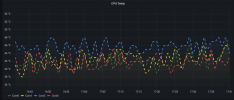Ja die Überschrift sagt eigentlich alles: Ich möchte gerne die CPU Kern Temperaturen monitoren, diese also mit dem Proxmox Metric Server an meine InfluxDB übergeben.
Xsensors habe ich bereits installiert und dort werden die Kerntemperaturen auch korrekt ausgelesen. Kann ich diese irgendwie zusätzlich an den Metric Server übergeben?
Ich habe eine Telegraf Installation auf einer VM am Laufen aber für das Plugin "LM Sensors Input Plugin" müsste ja dann direkt auf dem Proxmox laufen damit ich die Daten damit ausgelesen bekomme.
Vielleicht hat ja einer ne Idee wie das am Einfachsten klappt
Wundert mich ohnehin etwas, dass die CPU Temperatur noch nirgends angezeigt wird im Proxmox. Ist ja keine ganz irrelevante Information.
Scheinbar wurde auch schon mal eine Anfrage zur Integration gestellt, wie ich im Forum irgendwo lesen konnte.
Xsensors habe ich bereits installiert und dort werden die Kerntemperaturen auch korrekt ausgelesen. Kann ich diese irgendwie zusätzlich an den Metric Server übergeben?
Code:
coretemp-isa-0001
Adapter: ISA adapter
Package id 1: +64.0°C (high = +75.0°C, crit = +85.0°C)
Core 0: +56.0°C (high = +75.0°C, crit = +85.0°C)
Core 1: +57.0°C (high = +75.0°C, crit = +85.0°C)
Core 2: +55.0°C (high = +75.0°C, crit = +85.0°C)
Core 3: +56.0°C (high = +75.0°C, crit = +85.0°C)
Core 4: +57.0°C (high = +75.0°C, crit = +85.0°C)
Core 5: +55.0°C (high = +75.0°C, crit = +85.0°C)
coretemp-isa-0000
Adapter: ISA adapter
Package id 0: +62.0°C (high = +75.0°C, crit = +85.0°C)
Core 0: +55.0°C (high = +75.0°C, crit = +85.0°C)
Core 1: +54.0°C (high = +75.0°C, crit = +85.0°C)
Core 2: +54.0°C (high = +75.0°C, crit = +85.0°C)
Core 3: +57.0°C (high = +75.0°C, crit = +85.0°C)
Core 4: +56.0°C (high = +75.0°C, crit = +85.0°C)
Core 5: +55.0°C (high = +75.0°C, crit = +85.0°C)Ich habe eine Telegraf Installation auf einer VM am Laufen aber für das Plugin "LM Sensors Input Plugin" müsste ja dann direkt auf dem Proxmox laufen damit ich die Daten damit ausgelesen bekomme.
Vielleicht hat ja einer ne Idee wie das am Einfachsten klappt
Wundert mich ohnehin etwas, dass die CPU Temperatur noch nirgends angezeigt wird im Proxmox. Ist ja keine ganz irrelevante Information.
Scheinbar wurde auch schon mal eine Anfrage zur Integration gestellt, wie ich im Forum irgendwo lesen konnte.


